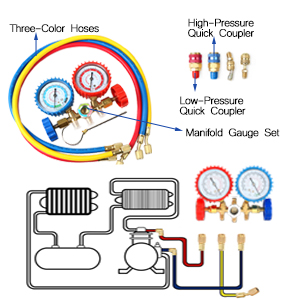How To Use AC Vacuum Pump For Pulling Out The Moisture?
Introduction:
An air conditioning vacuum pump is an essential tool for any HVAC technician. It is used to remove air and moisture from an air conditioning system before it is charged with refrigerant. The vacuum pump creates a vacuum in the system, which allows any moisture and air to be removed. This process helps to prevent any contaminants from entering the system, and it ensures that the refrigerant can be properly circulated throughout the system. In this article, we will discuss how to use an AC vacuum pump.

Step 1: Gather the Necessary Tools
Before you begin using the vacuum pump, you will need to gather all of the necessary tools. This includes the vacuum pump itself, a vacuum gauge, a refrigerant manifold gauge set, a can of refrigerant, and a vacuum pump oil. You will also need a set of refrigerant hoses and a valve core removal tool.

Step 2: Safety Precautions
It is important to take safety precautions when using an AC vacuum pump.
Always wear protective eyewear and gloves to prevent injury. Additionally, make sure that you are working in a well-ventilated area to avoid inhaling any fumes from the refrigerant or vacuum pump oil.
Step 3: Prepare the System
Before you can use the vacuum pump, you will need to prepare the air conditioning system. Begin by shutting off the power to the system. Next, remove the valve cores from the service ports on the system. You can use a valve core removal tool to do this. Once the valve cores have been removed, attach the refrigerant hoses to the service ports. Make sure that the hoses are securely attached.
Step 4: Connect the Vacuum Pump
Once the hoses are attached to the service ports, you can connect the vacuum pump to the manifold gauge set. The manifold gauge set will allow you to monitor the vacuum pressure in the system. Connect the vacuum pump to the center port on the manifold gauge set. The other two ports on the manifold gauge set should be connected to the refrigerant hoses.

Step 5: Evacuate the System
Next, turn on the vacuum pump and begin evacuating the system. The vacuum pump should be able to create a vacuum of at least 500 microns. Allow the vacuum pump to run for at least 30 minutes to ensure that all of the air and moisture has been removed from the system.
You can use the vacuum gauge on the manifold gauge set to monitor the vacuum pressure in the system.
Step 6: Check for Leaks
After the system has been evacuated, you will need to check for leaks. Turn off the vacuum pump and allow the system to sit for at least 10 minutes. If the vacuum pressure remains steady, there are no leaks in the system.
However, if the vacuum pressure drops, there is a leak in the system that will need to be repaired before refrigerant can be added.
Step 7: Add Refrigerant
If there are no leaks in the system, you can begin adding refrigerant. Turn off the vacuum pump and remove the hoses from the service ports. Replace the valve cores in the service ports and tighten them with a valve core removal tool.

Next, connect a can of refrigerant to the refrigerant manifold gauge set. Open the valve on the can of refrigerant and slowly add refrigerant to the system. You can use the manifold gauge set to monitor the pressure in the system as you add refrigerant.